Conversation with a Rancher: Steward or Threat
A chance meeting with a rancher in the middle of the Nevada wilderness offers another side to the controversy surrounding the environmental effects of agriculture.
This conversation took place a little over a decade ago, but many of these issues continue to this day. Lucas' view of life in the Great Basin is only one opinion and may have contradictory messages. It's important, though, to listen to people who live on the land, who see the environmental changes and the effects brought on by the many stakeholders who use or govern the use of the land. Cultural differences between urban and rural communities have divided people to the point we no longer value each other's knowledge. We refuse to learn from each other; relying on what social media tells us with its simplistic memes. I value what Lucas had to tell us. I hope his remarks will open meaningful discussions for my readers.
While scouting out our post for the Pony Express Re-Ride in the mountains near Eureka, NV, a young rancher we'll call Lucas approached us in what appeared to be a golf cart tricked out with all-terrain tires and a solar panel that also provided shade. Over the next hour, he explained his side on a number of environmental and economical issues often distorted by the media's political spin. It's one thing to listen to those who study the environment from an academic point of view. Even though such people see changes over the years during short field trips, there's little comparison to the vigilance of those who live on the land all their lives.
Lucas's great grandfather brought his family from Italy to build a ranch near Fallon, NV, where they are currently headquartered. Each year, they run cattle in the mountains east of Diamond Valley. Eventually, they purchased the ranch they had leased for years.
Cloud Seeding and the Drought
As Lucas gazed across the area where we paused to talk, he raised his hand about two feet off the ground. "The grass here is usually this high by now," he said. Meager plants were all that grew in the rocky soil. "I've talked to the old timers out here and they say this is the worst year yet." Even after the winter of 2011, which filled the drought-drained reservoirs to capacity, the winter of 2012 left the Great Basin drier than ever seen in history.
"Usually this pass gets over six feet of snow in winter, but this year, there was no snow on the mountain tops," he said. This snow is essential for recharging the aquifers. "Many of the springs didn't artise this year. Here is it June and it's dry. I don't know what we'll do in August."
"The climate is changing out here," he continued, but he doesn't blame carbon-based fuels. "They've been cloud seeding in the Sierra Nevada and that has been changing the weather out here."
Indeed, the Desert Research Center in Reno has installed four cloud seeding stations in the Sierra Nevada near Lake Tahoe in order to increase amounts of precipitation.
Most of the Great Basin falls in the rain shadow of the Sierra Nevada, but many of the mountain ranges across Nevada are high enough to catch high-level moisture flows and bring it to the valleys, especially on the eastern half of the state. It seems that a line could be drawn through the middle of the state. While the western half is arid with several playas forming dust devils in the wind, the eastern side of Nevada is lush with pinion forests.
Local ranchers do all they can to preserve and carefully monitor their water usage. When cloud seeding removes the natural flow of precipitation over a large area, however, it affects the lives of people and the economy there.
It doesn't make Lucas feel good knowing that powers beyond his control have such influence over his family's ranching efforts.
Removing the People from the Land
"It's like they're trying to get us off the land," Lucas said. His remark reminded me of a documentary where a BLM manager in Idaho proclaimed his mission was to do just that. Through severe regulations and other random edicts, he would wear people down to the point of walking away from ranches that had been in the families for over five generations.
"Everyone blames the ranchers for destroying everything, then they let the mines do anything they want."
He points to a huge mine across the valley from where we stood. Its mine tailings formed gigantic alluvial deposits across the mountainside.
"Why don't they take all that dirt and fill in the holes when they're done," he grumbled. "We ranchers grow food. People seem to forget that."
Changes in Credit Rules
It's not just the mines that threaten ranchers. Corporations are buying up ranches as they succumb to economic downturns. Lucas told us that banking rules for ranch loans have changed which forces many ranchers to quit.
Lucas said that, for decades, banks allowed ranchers to have revolving credit loans. Each year, a rancher could pay against the loan and still be able to borrow more if needed to keep the ranch working.
Since the 2007 recession, though, Lucas told us that this credit arrangement has changed. Ranchers must payoff the entire loan before borrowing more money. "When the ranch fails because of lack of cash flow, a corporation buys the ranch," he said.
We had noticed while driving to this site that some ranches bore the names of corporate owners. Ranch and farmlands throughout the U.S. have become lucrative options for stock portfolios for billionaires. When asked why he purchases agricultural properties, one billionaire said that he leaves such investments up to the discretion of his financial manager. Apparently, the land is merely a commodity rather than a cultural heritage as well as a supplier of food.
An Ironic Family Twist on Food Safety
When Lucas's family emigrated from Italy four generations ago, half went to Brazil and half settled in Nevada. According to Lucas, the Brazilian branch can sell cattle without the food restrictions and environmental regulations that American ranchers and farmers must observe.
"In fact," he said, "Mexican cattle can be driven over the border on the hoof to be sold and the ranchers there haven't had to follow the rules we do. They can dip their animals in all the toxic stuff they want that we can't use."
Loss of Faith and Wild Horses
Lucas stated outright that he has lost his faith in the government, not only in their lack of regard for ranchers' rights and needs, but their inability to steward the land.
He mentioned the problem in the area with wild horses. "The BLM has limited this area to 68 horses, but there are over 700 running through these mountains. That's too many. They need to gather them."
I complained that the BLM uses helicopters instead of hiring cowboys to gather the horses. His answer surprised me.
"It's a lot safer for the horses to use helicopters. This country is too rugged to use cowboys to gather the horses. Fewer horses are killed when they use helicopters." He further explained that the terrain in the area is too rocky and treacherous for horses.
Then I realized he had swapped a cow horse for his vehicle to survey the narrow canyon where his cattle ranged. In fact, we saw some cows as we navigated the boulders and holes in the road to the summit where we would be camping. A horse would stumble and possibly break a leg in this place. Wild horses, on the other hand, evolved in this terrain by developing thicker, sturdier legs and wilier survival instincts that domestic horses, even well-trained cow horses, don't possess.
"But the videos show the helicopters causing problems. They create stampedes and have killed foals and even some adults." I said.
He countered that people take photos based on their particular agenda. My husband agreed, telling about an incident where an environmentalist photographer took photos from a particular angle for greatest negative effect. When asked about this, the photographer stated that all means were justified to support the organization's agenda.
Lucas doesn't hate wild horses. Instead he told us how stressed they become when populations grow beyond the resources.
"They fight each other over water. I've seen them stomp on the springs, trying to get to the water, and all they manage to do is destroy the spring."
"There may be a few killed during helicopter gathers, but many more of them will die from winter kill and starvation."
I had to admit I'd heard the same argument from other ranchers. Despite their survival instincts, wild horses still bear the brunt of Nature's capricious weather and changing range conditions. Some of the ranges are lush with grass, but others have become arid wastelands. In their travels to find better grazing, resident herds may not be so welcoming of newcomers to their territories.
Stewards of the Land
Lucas's lack of faith in government institutions comes from how they control the environment. Science and plain, old-fashioned observation sometimes doesn't bring logical results.
For example, Lucas told us how sage grouse like to graze grasslands because they can see the predators. Also, the grouse like the fresh, young sprouts that emerge from the cropped grasses after cattle have grazed there.
"The government's got this big wildlife refuge (Sheldon National Wildlife Refuge) where grazing isn't permitted. The grouse all fly into the neighboring private ranchlands because they prefer that short grass."
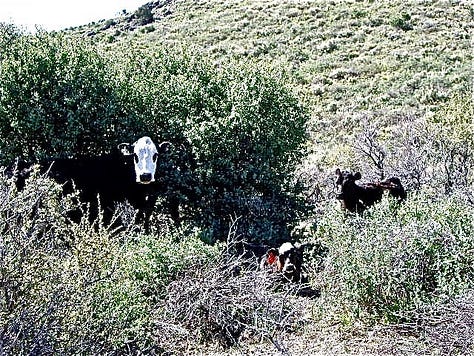
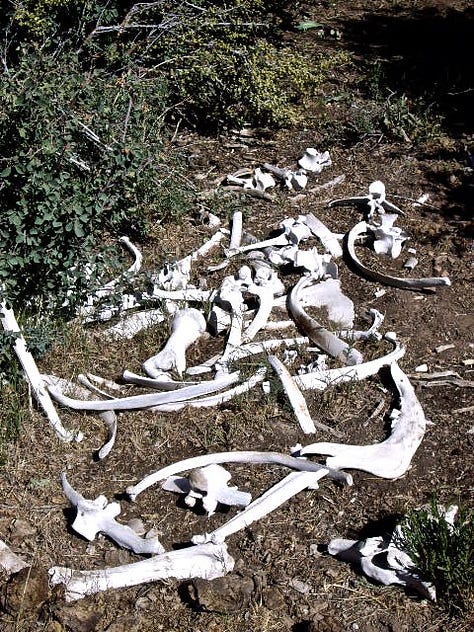
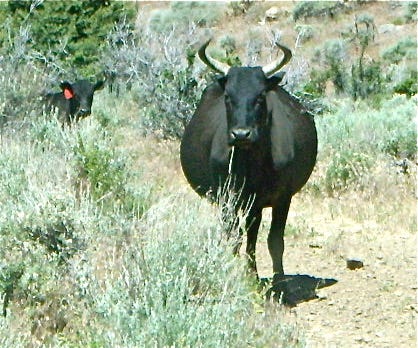
Predators and Prey
Another issue is the deer and predator populations in the canyon where Lucas runs his cattle.
"The Fish and Game (Wildlife) sells permits to hunt the deer. Since the recession, they've been selling more permits to make more money for the department. The hunters take more deer than they should. Then the mountain lions eat my cattle."
We mentioned seeing a scattering of cow bones near the gate to his property. "Is that a cougar kill," I asked.
"Yes it is," he said. "They treed five lions in this canyon last summer. That's far too many for the deer population. But when the government messes around with the natural population, things get out of balance."
Ranchers are not the problem, as environmentalists seem to think, Lucas told us. "The cattle eat the cheat grass which keeps the fire danger down. The sage grouse like it that way. And if there were enough deer for the lions, my cattle wouldn't be in danger."
"You have these government scientists not using good information. At one meeting, a scientist was telling us how crows can't eat the grouse eggs because they're too big to get their beaks around. 'So how do you get rid of the crows,' some guy asks, and the scientist says 'we used poisoned eggs.'" Lucas rolls his eyes.
As we continued on our journey, my husband and I felt we had received a plentiful and eye-opening amount of information from a source that was boots on the ground for environmental stewardship.
"If ranchers abuse the land," Lucas stated, "we lose our way of making a living. We hurt ourselves as well as the land."
All photos by Sue Cauhape.
We’re no longer participating in the Pony Express Re-Ride, however, if you would like to read our last experience with the Pony, here’s my post from June 2024: Night Out Yonder
If you enjoyed this post, feel free to explore other writings in the Ring Around the Basin Archive. I also love to read your comments, so please share your thoughts. Let’s start a conversation. And if you wish to support my writings, please consider subscribing or upgrading to a paid subscription. It’s now only $50/year. Even better, I would appreciate it if you could share Ring Around the Basin with your friends. Thank you!


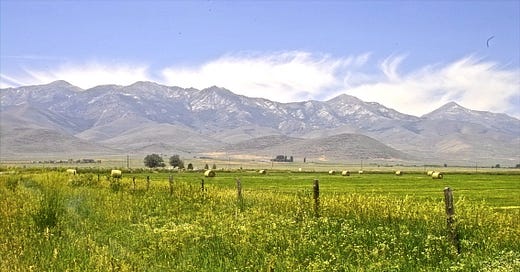




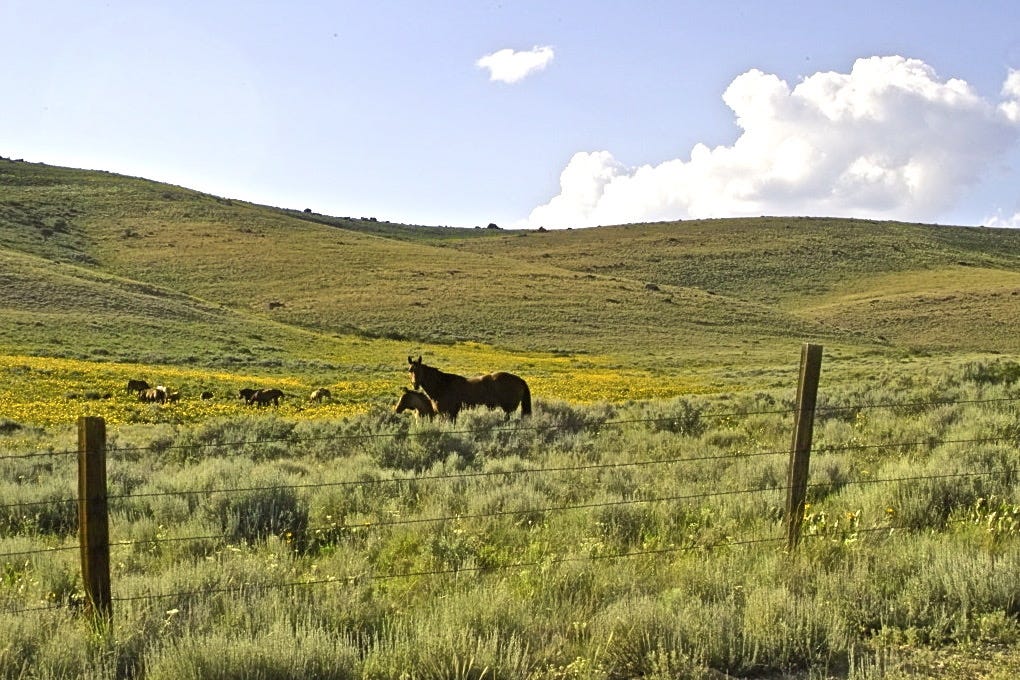
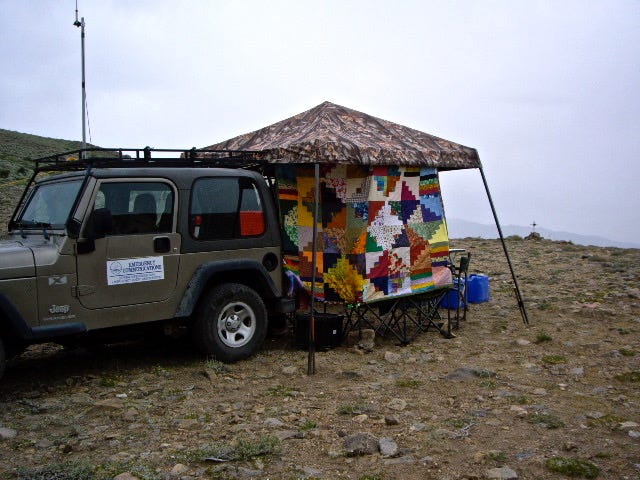

Illuminating article, Sue. It really highlights the way farmers and free range ranchers are treated in this country and how it's only getting worse due to political greed and short-term thinking. I fear the regional impact from mining companies will now only get worse since the Trump administration has given them the unregulated freedom to run rampant over both public and private lands.
Five words: Jon Marvel, Western Watersheds Project.
https://www.tsln.com/news/western-watersheds-project-welfare-environmentalists/
I was talking to an Idaho agricultural extension agent about a ranch WWP bought near Challis as a model ranching operation. The extension agent and a colleague were invited to visit it. He noted a number of washouts, the presence of noxious weeds, and a generally neglected landscape. So much for architects and lawyers showing ranchers how it really should be done.